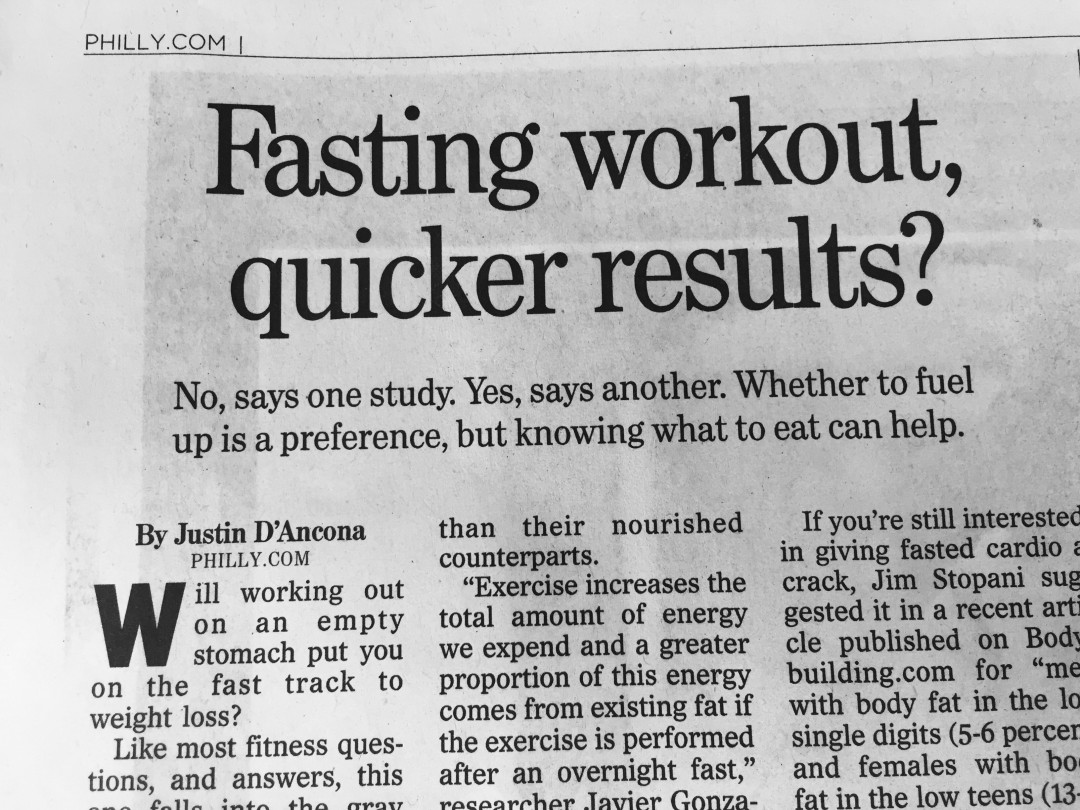This Sunday’s Philadelphia Inquirer Health section featured an article by Justin D’Ancona entitled Fasting workout, quicker results? with a number of quotes from yours truly. It first tackled the question of fasted workouts and their usefulness before handling workout prescriptions. Here, for your benefit, are 6 expanded takeaways. #6 is my favorite, so if you’re in a rush, jump to it.
1: “Like most fitness questions, and answers, this one falls into the gray area.” – Justin D’Ancona
Smart, smart, SMART quote from D’Ancona. The article itself tackles two studies that fall on opposite sides of the fasted workout equation. One proclaims no results, while the other reports significant – up to 20% bodyfat! – improvements in its subjects.
Your takeaway here is to stop headline hunting because headlines tell you very little. Studies can be flawed and have an assortment of small sample sizes, biases in gender, age, ability, etc, and narrow thinking (displaying a positive/negative without considering a resulting positive/negative elsewhere). Studies are useful – yes! – but they require your critical thinking and personal experimentation to derive real results.
2: “The researchers discovered those in the group that exercised fasted didn’t compensate for missed meals by consuming additional calories during lunch, nor did they complain of an increased appetite for the remainder of the day.” – Justin D’Ancona
Here’s an example of a study takeaway that requires the aforementioned critical thinking and personal experimentation. It’s an intriguing idea. Can you fast through breakfast, not suffer cognitively or physically, and consume fewer calories (which would in theory be an effective weight loss strategy)?
My experience with fasted exercise is this: it works for lower stress output. If you’re typically more relaxed in the morning and walking or doing low intensity work, it’s worth considering. If, however, you’re a morning high performer and doing higher intensity work, my experience says it will break you.
3: “For the most part, my recommendation is to eat balanced… My philosophy revolves around a positive source of protein, positive source of carbohydrate, positive source of fat.” – Me
“Low” or “no” anything are short-term strategies and are maaaaybe applicable from-time-to-time for the right reasons. If you consistently and significantly deprive anything, it’ll have unintended consequences. Give yourself well-rounded and focus on quality sourcing.
4: “Get a big strength workout and a big sprint workout in a week. Where with the strength workout you’re pushing your limits on the type of weight that you’re able to push, pull, squat, and deadlift…” – Me
Strength is the foundation of your house. Quick message to the ladies: if I never again hear the “but I don’t want to get muscular” retort to my strength programming, I’ll die happy.
After your best friend of walking – yes, walking – strength is next on your priority list. It’ll sustain and build muscle mass, which is worth its weight in gold, while also preparing you for the daily stressors of life – picking up babies, landscaping, snow shoveling, and playing pickup sports.
Quick self-evaluation: If you are someone with back pain AND someone who regularly shirks strength training (with sound form, of course), re-evaluate your life. Immediately.
5: “…And then on your sprint workouts, you’re working shorter, but super high intensity. So, like, 30 [seconds] on, a minute off, eight times, but every time you’re doing that 30 on, toward the end of that 30 you’re really struggling.” – Me
Intensity. Scaling yourself up the intensity spectrum sends a direct signal to your primal physical wiring to improve… or else. If you want that next chunk of physical results, you’d best find the time to sprint.
A few words on sprinting. My definition: performing an activity as intensely as possible for the prescribed block of time. That means if it’s :10, you’re dying at the 10th second. If it’s :30, you’re spent at 30. Get comfortable with the uncomfortable.
6: “Wait, weight loss results from only two workouts per week? ‘I think people usually start too fast with too much. Prove to me you can do two workouts a week first.'” – Me
More is not better. It’s not.
Thought experiment: would you rather…
- Train like hell for 10 weeks, work yourself up to a physical peak you enjoy for 2-to-4 weeks, and plummet off a cliff without a parachute. End scene: 1-year later you wake up in a worse position than you were to begin with.
- Develop reasonable health habits that progress you slower up a hill (not a mountain). End scene: 1-year later you wake up in the best shape of your life with the ability to sustain it.
I get that you want results, and you want them NOW. I get it. But do you really want to vacillate between periods of killing yourself for 6 workouts a week, getting injured and/or petering out, then not doing a damn thing? Do you really aspire to be a physical yo-yo?
Start reasonably. Sink your energy into walking, strength, and sprinting (Have you listened to the Keith Norris podcast yet? We handle that exact formula.) Prove that formula to yourself. Then add the frills if you’d like.






